Dolgellau
| Dolgellau | |
| Merionethshire | |
|---|---|
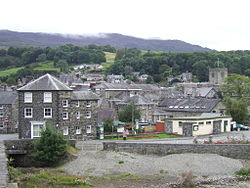 Dolgellau | |
| Location | |
| Grid reference: | SH728178 |
| Location: | 52°44’24"N, 3°52’48"W |
| Data | |
| Population: | 2,678 (2001) |
| Post town: | Dolgellau |
| Postcode: | LL40 |
| Dialling code: | 01341 |
| Local Government | |
| Council: | Gwynedd |
| Parliamentary constituency: |
Dwyfor Meirionnydd |
Dolgellau is a market town in Merionethshire, standing on the banks of the River Wnion, a tributary of the River Mawddach.
The town was the centre of a minor gold rush in the 19th century. At one time the local gold mines employed over 500 workers. Clogau St. Davids goldmine in Bontddu supplied gold for many royal weddings. Gwynfynydd goldmine, in Ganllwyd, also supplied the gold for the more recent royal weddings.
Today, the economy of Dolgellau relies chiefly on tourism with agriculture in a lesser a role. A farmers' market is held in the town centre on the third Sunday of every month.
The name "Dolgellau"
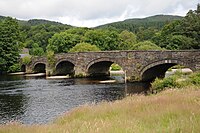
The name of the town is of uncertain origin, but it appears to contain common elements. Dôl is Welsh for "meadow", and cellïau) means "groves" or "spinneys", and each is common locally in names for farms in sheltered nooks. This would seem to be the most likely derivation, giving the translation "Meadow of Groves". It has also been suggested that the name could derive from the word cell, meaning "cell", translating therefore as "Meadow of [monks'] cells", but this seems less likely considering the history of the name.
The earliest recorded spelling (from 1253, in the Survey of Merioneth) is "Dolkelew", although a spelling "Dolgethley" dates from 1285. From then until the 19th century, most spellings were along the lines of "Dolgelley", "Dolgelly" or "Dolgelli" (Owain Glyndŵr wrote "Dolguelli"). Thomas Pennant used the form "Dolgelleu" in his Tours of Wales, and this was the form used in the Church Registers in 1723, although it never had much currency. In 1825 the Registers had "Dolgellau", which form Robert Vaughan of Hengwrt adopted in 1836. Whether the final spelling, "Dolgellau", derives from a false etymology or not, it is the modern form in English and Welsh, although the town continued to be known as "Dolgelley" in English until quite recently.
A debate took place in the 1950s regarding the correct Welsh spelling and Dolgelli had its advocates before Dolgellau was settled pon. Shortly before the closure of the town's railway station it displayed signs reading variously Dolgelly, Dolgelley and Dolgellau.
History and economy
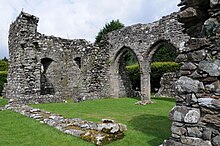
The area upon which Dolgellau stands was, in the pre-Roman Iron Age, part of the tribal lands of the Ordovices, who were subdued by the Romans in 77–78 AD. Although a few Roman coins from the reigns of Hadrian and Trajan have been found near Dolgellau, the area is marshy and there is no evidence that it was settled during the Roman period. There are, however, three hill forts in the vicinity of Dolgellau, of uncertain origin.
As Roman power declined, that of the native chieftains increased. Dolgellau itself was probably not inhabited until the late-11th or 12th century, when it was established as a royal manorial estate (or maerdref), possibly by Cadwgan ap Bleddyn, and it remained as such until the reign of King Henry VII (1485–1509).
A church was built at some point in the 12th century (demolished and replaced by the present building in 1716), although Cymer Abbey, founded in 1198 in nearby Llanelltyd, remained the most important religious centre locally. Dolgellau gained in importance from this period and was mentioned in the Survey of Merioneth ordered by Edward I while Llanelltyd was not. In 1404 it was the location of a council of chiefs under Owain Glyndŵr.
After a visit by George Fox in 1657, many inhabitants of Dolgellau converted to Quakerism. Persecution led a large number of them to emigrate to Pennsylvania in 1686, under the leadership of Rowland Ellis, a local gentleman-famer. The Pennsylvanian town of Bryn Mawr, home to a prestigious women's liberal arts college, is named after Ellis's farm near Dolgellau.
The woollen industry was long of the greatest importance to the town's economy and by the end of the 18th century, output was reckoned to be worth between £50,000 to £100,000 a year. The industry was to decline in the first half of the 19th century, however, owing to the introduction of mechanical looms. Another important contributor to the local economy was tanning, which continued into the 1980s in Dolgellau, though on a much reduced scale.
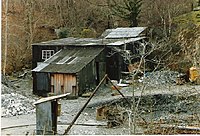
The town was the centre of a minor gold rush in the 19th century. At one time the local gold mines employed over 500 workers. Clogau St. Davids goldmine in Bontddu supplied gold for many royal weddings. Gwynfynydd goldmine, in Ganllwyd, also supplied the gold for the more recent royal weddings.
Today, the economy of Dolgellau has fallen back on farms and tourism.
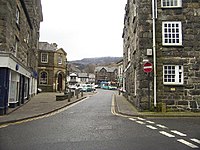
It is believed that Dolgellau Cricket Club, created in 1869, is the oldest cricket club in Wales. [1]
Literary connections
Near Dolgellau is the house of Hengwrt, whose 17th century owner Robert Vaughan (1592–1667) kept an extensive library. This was home, among other treasures, to the Book of Taliesin, the Black Book of Carmarthen, the White Book of Rhydderch and the Hengwrt manuscript.
In 1971 John Elwyn Jones, a retired teacher who had taught Russian, German and Welsh at Dr Williams School, published Pum Cynnig i Gymro ("Five Tries for a Welshman"),[2] an account of his time as a Prisoner of War in Poland during World War II. The title of the book refers to the five attempts he made to escape, the last of which succeeded. The book was dramatised by S4C in 1997. In 1986 and 1987 John Elwyn published his autobiography in 3 volumes, called Yn Fy Ffordd Fy Hun ("In My Own Way"). These do not duplicate his Prisoner of War adventures, but recount his upbringing in the area—he was born at Bryn Gwyn, less than a mile from the town—and subsequent return to the area after his years in the armed services.[3]. He died in September 2007.
The modern Welsh writers Bethan Gwanas and Nia Medi live local to Dolgellau. Marion Eames lived in Dolgellau up to her death in 2007; she is probably best known for her book The Secret Room (originally published in Welsh as Y Stafell Ddirgel), a semi-fictional account of the events leading up to the 1686 emigration of Quakers from Dolgellau. It was dramatised by S4C in 2001.
Local attractions
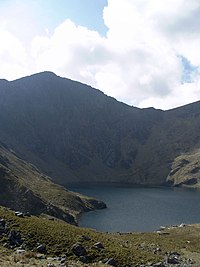
The surrounding area is known for its wild but beautiful countryside and places of historical interest. It is popular with tourists who enjoy activities such as walking, hiking, horse riding, white-water rafting and climbing. Dolgellau is the main base for climbers of Cadair Idris (known as Cader Idris locally).
The Great Western Railway line from Ruabon to Llangollen was extended via Corwen and Llanuwchllyn to Dolgellau, where it formed an end-on connection with the Cambrian Railways line from Barmouth Junction and a shared station was opened there in 1868. The Ruabon-Barmouth line was closed in the 1960s under the Beeching Axe. The railway line was converted some years ago into the Llwybr Mawddach (or "Mawddach Trail") which now runs for some eight miles from Dolgellau to Morfa Mawddach railway station, near Fairbourne on the coast. It is maintained by the Snowdonia National Park and is very popular with walkers and cyclists. It passes some estuarine areas that are important for water birds.
The site of Dolgellau railway station itself, along with approximately a mile and a half of former trackbed, was used to construct the Dolgellau bypass in the late 1970s.
Historical attractions, apart from the town itself, include the 12th century Cymer Abbey, a short walk from Dolgellau. The tourist information centre also has an exhibition on Quakers and there is a Quaker graveyard in the town. A field known as Camlan, in nearby Dinas Mawddwy, has been claimed as the site of the last battle of King Arthur (based on a mention of the name in the Annales Cambriae; see also Battle of Camlann).
Dolgellau is a good centre for visiting a number of nearby narrow-gauge heritage railways, including the Corris Railway, the Fairbourne Railway and the Talyllyn Railway.
Cultural Events
From 1992 to 2008 Dolgellau held Sesiwn Fawr (English: Big Session) an annual world music festival. Originally free and held in the streets of the town, it has now grown too big for the centre of Dolgellau. Since 2002 it has been held on the outskirts of the town and big name acts have appeared. From 1995 it was been broadcast live on BBC Radio Cymru and since 1997 on S4C.
The future format of the festival is currently under review.[4]
Every summer, Dolgellau is also host to the Gŵyl Cefn Gwlad ("Festival of the Countryside"), a mix of agricultural show and fête. Entry is free, but the money raised on the various stalls is given to good causes.
In 1949 Dolgellau hosted the National Eisteddfod; in 1960 and 1994 it hosted the Urdd National Eisteddfod.
Outside links
- Dolgellau.net
- History of Dolgellau
- Dolgellau Archives
- Dolgellau Cricket Club
- www.geograph.co.uk : photos of Dolgellau and surrounding area
Notes
- ↑ Archives Network Wales - Dolgellau Cricket Club Records
- ↑ Tri chynnig i Gymro ("three tries for a Welshman") is a more or less equivalent saying to the English "third time lucky". The book title is a play on this phrase.
- ↑ "Yn Fy Ffordd Fy Hun", in 3 volumes by John Elwyn. Published by Gwasg Carreg Gwalch, 1986/7. ISBN 0-86381-054-3 ISBN 0-86381-060-8 ISBN 0-86381-074-8
- ↑ No Sesiwn Fawr Dolgellau in 2009 in the Daily Post 5 March 2009